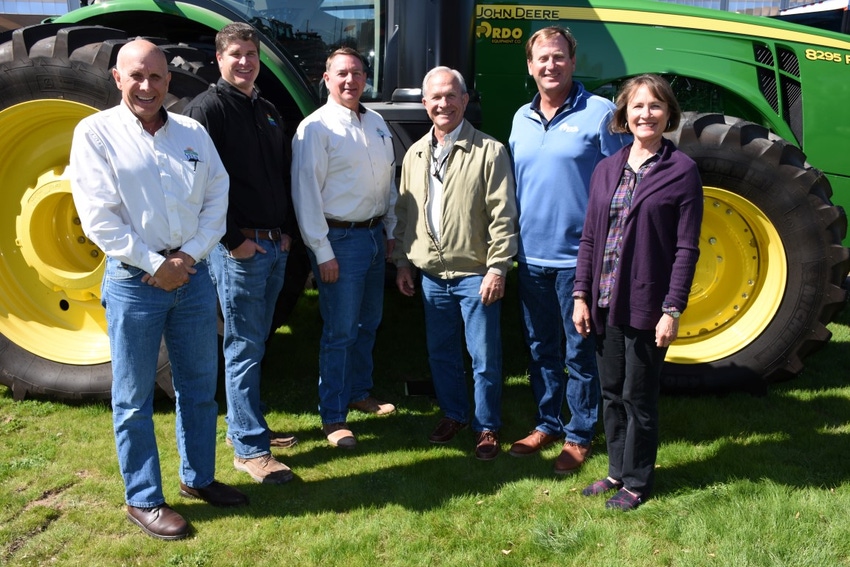March 15, 2017

While wet winter and spring weather delivered a deluge of moisture to many California growers, farming operations, and the state reservoirs, the massive weather system also delivered much needed drought relief in the overall seven-state Colorado River basin.
In the lower basin state of Arizona, the additional moisture will allow the central counties of Maricopa, Pinal, and Pima to stave off drought-related water cutbacks from the Colorado River for at least a few more years.
Central Arizona agriculture stands to lose 200,000 to 220,000 acre feet (AF) of water for irrigation, delivered by the Central Arizona Project (CAP). CAP operates a 336-mile aqueduct which delivers Colorado River water from Lake Havasu City to Phoenix and then south to Tucson to municipalities, agriculture, and Indian Tribes.
REAL BLESSING
The winter and spring storms were a real blessing for Arizona producers, says Chuck Cullom, CAP’s Colorado River programs manager.
In “August 2016, the probability of shortage (in Arizona) was greater than 50 percent for the next five years – for every year – upwards of 60 percent.”
Today, shortage prospects have dropped to about 30 percent.
“The risk has essentially been cut in half for the next five years because of the snowpack this year. We’ve (Colorado basin) had an incredibly wet December and January,” Cullom told about 900 agricultural folks gathered in late February for the 2017 Southwest Ag Summit held at Yuma, Ariz.
Cullom noted, “While I’m enthusiastic about the improvement it’s temporary and the structural deficit will erase these gains over the next couple of years.”
A Colorado River level one emergency shortage call was originally expected as early as last year or this year. The extra basin moisture could push back water reductions to central Arizona farms to about 2019 or later.
EYES ON LAKE MEAD
Meanwhile, Arizona water leaders have their eyes peeled on the water mark at Lake Mead, the storage reservoir for the lower basin states and the largest reservoir in the nation. When the Mead dipstick measures water under the 1,075-foot mark around August of any given year, the secretary of the Interior can declare a Colorado River level one shortage call.
Arizona, specifically the central portion, would face the first water cuts under a shortage for the three lower basin states – California, Arizona, and Nevada. The annual Colorado River apportionment for these three states is 4.1 million acre feet for California, 2.4 million AF – Arizona, and 300,000 AF - Nevada.
California has senior rights in the lower basin and would receive every drop of water under its 4.1 million AF allotment under a level one shortage situation. Only Arizona’s allotment would be cut by 325,000 AF total which includes the 200,000 to 220,000 AF specifically earmarked for agriculture (75 percent of the reduction).
Also cut would be 75,000 to 100,000 acre feet of water (25 percent) normally shifted to underground storage (excess pool) by the Arizona Banking Authority and held for Arizona water emergencies.
AGRICULTURAL EFFICIENCY
Cullom says water delivery cutbacks to food and fiber growers in Arizona’s tri-county area would be “unfortunate.”
“Arizona has some of the most efficient agriculture in the West, if not the nation,” Cullom told the told the Ag Summit crowd. “(It would be) a significant reduction to ag.”
The water reductions would impact about 17 irrigation districts with CAP contracts.
With less surface water available to grow food and fiber, many farmers in the affected areas would be required to shift to more groundwater use to irrigate crops. This could be a serious problem for some growers as many old wells are in disrepair and repairs would be expensive at a time when grower prices for many of the major crops grown in the area – wheat, alfalfa, and cotton – are low. Some farm fields would likely be fallowed.
Under a level one call, the greater Yuma area in the state’s southwestern most reaches – regarded as the nation’s “winter salad bowl” leafy greens capital - would receive 100 percent of its river allotment due to its senior Arizona water rights on the river.
Each basin – the upper and lower - receives 7.5 MAF of water annually from the river. The upper basin states include Wyoming, Colorado, Utah, and New Mexico. The lower basin total also includes mandatory Colorado River water sent to the Republic of Mexico.
REGIONAL CONSERVATION
Cullom spent part of his presentation discussing various conservation efforts to reduce Colorado River water use inside and outside the CAP service area on a voluntary compensated basis – basically paying people not to use water.
One near term strategy is the Lake Mead protection program started in 2014 to keep the lake above the trigger level.
Cullom explains, “Suffering a 320,000 AF reduction for the CAP will impact our customers, the economy of central Arizona which is linked to the ag economy in Yuma, and that starts a problem that would be difficult to stop.”
He discussed a joint upper-lower basin initiative called the Pilot System Conservation Program, a cooperative agreement between the Bureau of Reclamation, Metropolitan Water District of Southern California, CAP, Southern Nevada Water Authority, and Denver Water.
These groups which represent the upper and lower basins are pooling financial resources to fund competitive conservation projects across both basins.
The projects would help mitigate drought across the entire Colorado River basin to help all users offset declining reservoir levels at lakes Mead and Powell. Lake Powell is the storage reservoir for the upper basin states, and the second largest U.S. reservoir.
You May Also Like




